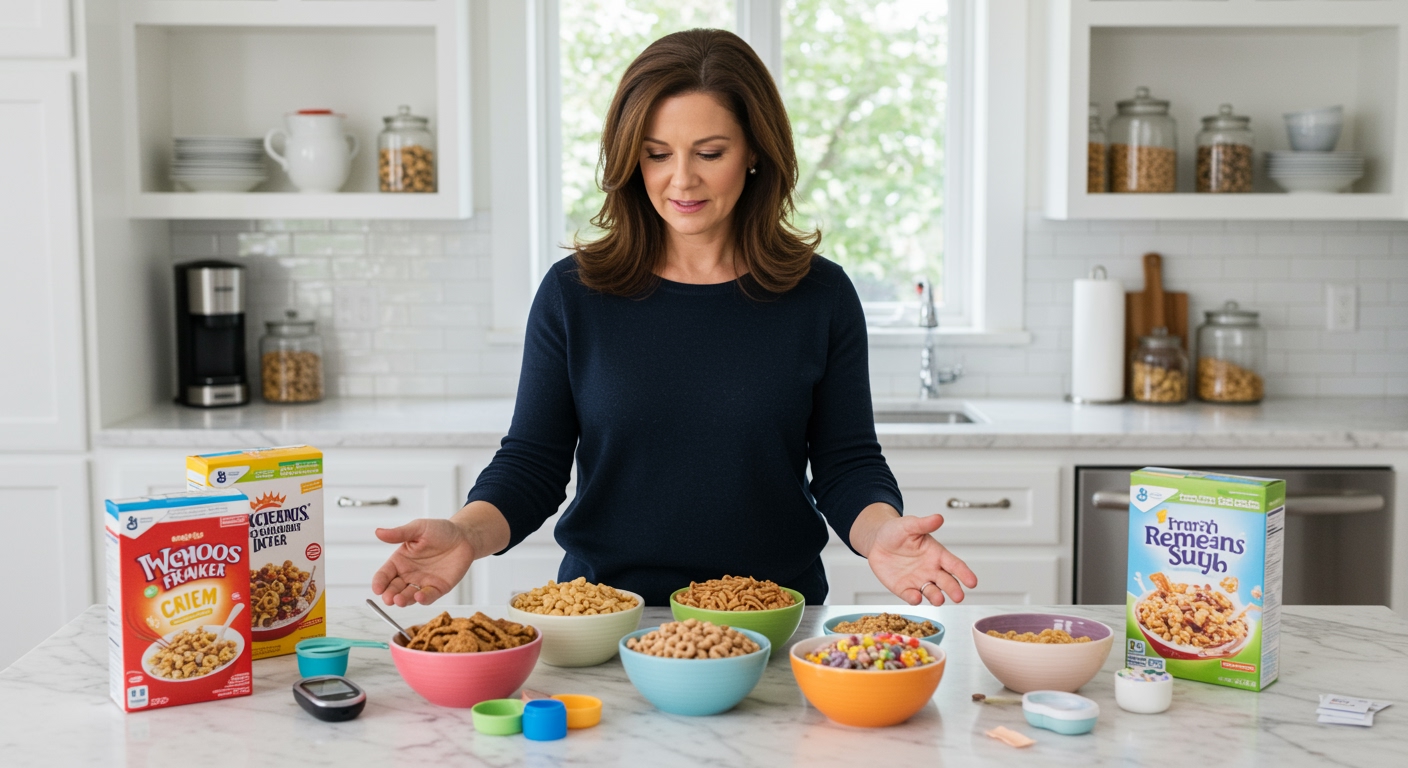✪ Key Takeaway: Most breakfast cereals spike blood sugar dangerously, but high-fiber, low-sugar options can be diabetes-friendly choices.
Introduction
Your morning cereal choice could be sabotaging your blood sugar control without you even knowing it.
You might be wondering if your favorite breakfast cereal is helping or hurting your diabetes management because conflicting information makes it hard to know what to believe.
Hi, I am Abdur, your nutrition coach and today I am going to explain exactly which breakfast cereals work for diabetes and which ones you should avoid completely.
Why Do Most Cereals Cause Blood Sugar Spikes?
Most breakfast cereals are processed carbohydrate bombs that hit your bloodstream like a sugar tsunami.
The manufacturing process strips away natural fiber and nutrients, then adds back synthetic vitamins and loads of sugar.
This creates a high glycemic index food that causes rapid blood sugar spikes within 30 minutes of eating.
Your pancreas responds by releasing large amounts of insulin to bring blood sugar down quickly.
This insulin surge often causes blood sugar to drop too low, triggering hunger and cravings for more sugary foods within 2-3 hours.
The cycle repeats throughout the day, making blood sugar control nearly impossible.
Research shows that people with diabetes who eat high-glycemic breakfast cereals have significantly higher HbA1c levels compared to those who choose low-glycemic options.
✪ Fact: Popular cereals can have glycemic index values above 80, similar to pure glucose.
Which Cereals Are Actually Safe For Diabetes?
Safe cereals for diabetes must meet three critical criteria: high fiber content, low added sugar, and minimal processing.
Look for cereals with at least 5 grams of fiber per serving and less than 6 grams of sugar.
Steel-cut oats top the list because they contain beta-glucan fiber that slows glucose absorption and improves insulin sensitivity.
Bran-based cereals work well because the outer grain layer provides substantial fiber that creates a protective barrier around carbohydrates.
This fiber barrier slows digestion and prevents the rapid glucose spikes that damage blood vessels over time.
Whole grain cereals without added sugars maintain their natural nutrient profile and fiber content.
Studies demonstrate that people who eat high-fiber cereals have better glucose control and lower insulin requirements throughout the day.
✪ Pro Tip: Add nuts or seeds to increase protein and healthy fats for even better blood sugar stability.
How Does Portion Size Affect Blood Sugar Response?
Even diabetes-friendly cereals can cause problems when you eat oversized portions that exceed your carbohydrate tolerance.
Most people pour 2-3 times the recommended serving size without realizing it.
A standard cereal serving is typically 3/4 to 1 cup, but restaurant-sized bowls encourage massive portions that overwhelm your glucose control systems.
Your body can only process a limited amount of carbohydrates at one time without causing blood sugar spikes.
When you exceed this threshold, even high-fiber cereals will cause significant glucose elevation that takes hours to normalize.
Using measuring cups or a food scale helps you understand true serving sizes and maintain consistent carbohydrate intake.
People who measure their cereal portions have more predictable blood sugar patterns and better long-term diabetes outcomes.
✪ Note: Use smaller bowls to naturally reduce portion sizes without feeling deprived.
What About Milk And Other Cereal Additions?
The milk you choose with cereal significantly impacts your total carbohydrate load and blood sugar response.
Regular milk contains lactose, a natural sugar that adds 12 grams of carbohydrates per cup.
This extra sugar combines with cereal carbohydrates to create a double glucose hit that can overwhelm your insulin response.
Unsweetened almond milk, coconut milk, or other plant-based alternatives contain only 1-2 grams of carbohydrates per cup.
These alternatives provide the creamy texture you want without the blood sugar consequences of dairy milk.
Adding fresh berries increases fiber and antioxidants while providing natural sweetness that satisfies cravings.
Research shows that people who use low-carb milk alternatives have more stable post-meal glucose levels and better appetite control.
✪ Pro Tip: Greek yogurt mixed with cereal provides protein that slows carbohydrate absorption naturally.
Should You Avoid Cereals Completely With Diabetes?
Complete cereal avoidance is unnecessary if you choose the right types and eat them strategically as part of a balanced meal plan.
The key is understanding that cereal should be treated as a carbohydrate source that requires careful planning and portion control.
Eating cereal as part of a complete breakfast with protein and healthy fats creates better blood sugar stability than eating it alone.
Adding eggs, nuts, or Greek yogurt provides protein that slows glucose absorption and extends satiety.
Timing matters too – eating cereal earlier in the day when your insulin sensitivity is naturally higher produces better glucose responses.
Many people with well-controlled diabetes successfully include appropriate cereals in their meal rotation without problems.
The goal is making informed choices based on your individual glucose response and overall health goals.
✪ Fact: Testing blood sugar 2 hours after eating helps you identify which cereals work best for your body.
The Bottom Line
Breakfast cereals can be part of a diabetes-friendly diet when you choose high-fiber, low-sugar options and control your portions carefully.
The best diabetes management happens when you make informed food choices based on how your body actually responds, not just what the marketing claims promise.
I would love to hear about your experiences with breakfast cereals and diabetes management, so please share your questions or thoughts in the comments below.
References
At NutritionCrown, we use quality and credible sources to ensure our content is accurate and trustworthy. Below are the sources referenced in creating this article:
- Healthline: Diabetes Healthy Cereal Brands
- PubMed: Glycemic Index and Diabetes
- PMC: Fiber and Blood Sugar Control
- Harvard Health: Good Guide to Good Carbs
- Diabetes UK: Breakfast Cereals and Diabetes





